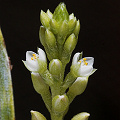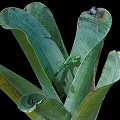Q: Brocchinia: the species
A: There are about twenty known species of Brocchinia, and no
doubt plenty more that haven't been described. One species, Brocchinia tatei, can reach enormous
dimensions (about 1.5m
in diameter). However, only two species are regularly considered likely to be carnivorous:
Brocchinia hechtioides Mez and Brocchinia reducta Baker.
They can only be reliably identified
when in flower.
Lowland and highland populations of Brocchinia exist, and may
represent different taxa at some level, but probably not at any rank of significance.
Hybrids are reported, which confuse things even further
So little work has been done on these species in a comprehensive way that if botanists conclude they should be merged into a
single species, or perhaps discover additional species, no one will be surprised.
B. reducta
I am starting here, with the plant more familiar to carnivorous plant growers.
The structure of this species is that of a tight column, and prey is apparently
caught only in the central urn.The inflorescences are mostly bipinnate.
B. hechtioides
With about 5-15 leaves 30-60 cm long, is a little larger than Brocchinia reducta.
The leaves of this species creates a looser, more open trap with
more water stored in the leaf axils than in the central urn. Perhaps
Brocchinia hechtioides captures more of its prey in the axils, similar to the carnivorous bromeliad
Catopsis berteroniana?
The
inflorescences are mostly tripinnate. The general shape differences between the two plants
is certainly not to be used to identify cultivated collections--such plants tend to adopt an artificially spreading
appearance because of inadequate light.
B. tatei
A few times I have seen
Brocchinia tatei L.B.Smith added to this list as well, but not convincingly.
Page citations: Juniper, B.E., et al. 1989; Mabberley, D.J. 1987;
McPherson, S. 2006; Rice, B.A. 2006a.

